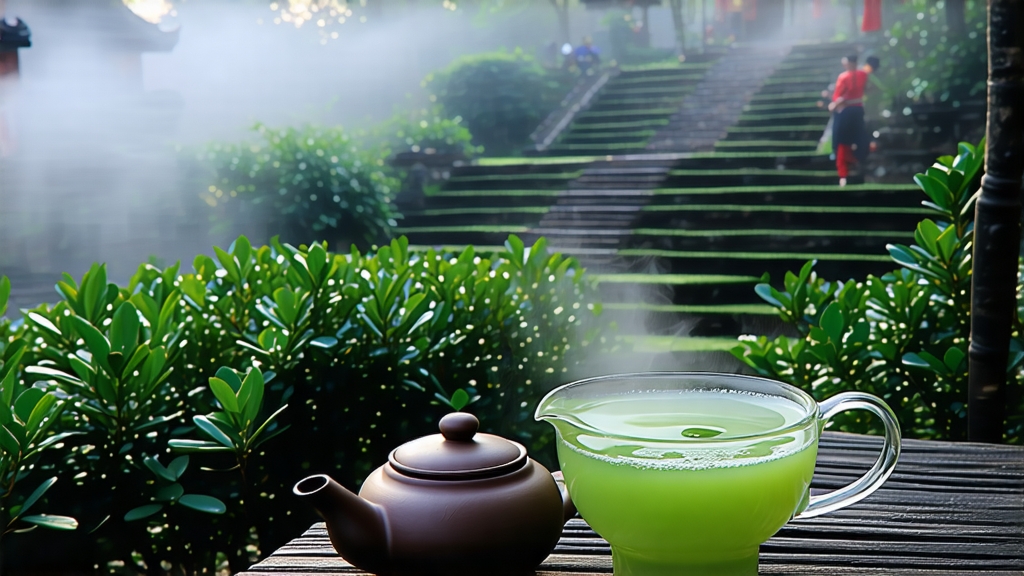
Few leaves carry as much poetry in their veins as Tie Guan Yin, the “Iron Goddess of Mercy.” Born in the granite folds of Anxi County, southern Fujian, this oolong is at once a cultivar, a craft, and a centuries-old legend that still shapes the daily rhythm of more than a million people. To understand Chinese oolong through only one lens, this is the lens to choose: it is half-green, half-black, yet wholly itself, a living paradox that can taste like lilacs one infusion and roasted chestnuts the next. What follows is a complete traveler’s map—history, garden, factory, kettle, and cup—so you can meet the goddess on her own terms.
-
Myth and Memory
Local chronicles place Tie Guan Yin’s birth sometime between 1725 and 1735, during the Yongzheng reign. A devout farmer named Wei Yin reportedly found a lone tea shoot beside the abandoned Guanyin temple near Xiping village. He transplanted it into his field, and the plant proved so fragrant that neighbors believed the Bodhisattva had rewarded his piety. A second, more romantic version credits the scholar Wang Shirang, who dreamed of the goddess leading him to a hidden bush on Yaoyang peak. Whatever the truth, by the late Qing the tea had already sailed on junks to Southeast Asia and was traded through the port of Xiamen under the poetic label “Ti Kuan Yin,” a phonetic whisper that still echoes in global auction catalogs. -
The Anxi Microcosm
Anxi sits on the Tropic of Cancer, but altitude rescues it from swelter. The best gardens perch between 600 m and 1,000 m in the “inner mountains” of Xiping, Gande, and Longjuan. Here, morning fog lingers until ten o’clock, filtering ultraviolet light and slowing photosynthesis; the result is a higher ratio of aromatic amino acids to bitter catechins. Granitic soils, rich in potassium and magnesium but poor in nitrogen, force roots to struggle, concentrating flavor. Even the local mist carries a faint orchid scent from wild cymbidiums blooming on cliff faces—an invisible terroir that ferries itself into the leaf. -
Cultivar Lineage
All authentic Tie Guan Yin springs from the original “Red Heart” (hongxin) strain, identifiable by its oval leaf, serrated edge, and a crimson dot at the petiole where it meets the stem. Over two centuries, clonal selection has produced sub-varietals such as “Green Heart” (lvxin), “Soft Stem” (ruan zhi), and the virus-resistant “Anxi Tie Guan Yin No. 2,” but purists still chase the slower-growing hongxin for its deeper “yin yun”—the lingering, cooling sensation that connoisseurs liken to the chime of a bronze bell. -
Craft: The Eighteen Bends
Unlike Yixing pots, which are shaped once and fired, Tie Guan Yin is a moving clay, kneaded by air, heat, and human palms across eighteen distinct steps. The choreography begins before dawn: leaves are plucked at “small to medium opening,” when the bud sports two or three companion leaves and the edges curl slightly inward. They are then withered in the courtyard on bamboo trays, sun-kissed for twenty minutes—just long enough for the grassy notes to retreat. Indoor withering follows, where conditioned air drops the moisture to 65 %. Shaking—perhaps the most photogenic stage—comes next. Dozens of leaves are tossed into a rattan drum that rotates like a lottery cage; edges bruise against veins, triggering oxidation only on the perimeter while the core stays green. This partial wounding is the secret behind Tie Guan Yin’s “green leaf with red fringe.” After four rounds of shaking and resting, the leaf aroma shifts from cut grass to ripe mango, the signal to fire. A 230 °C drum kill-green halts enzymes in ninety seconds, locking in the floral top notes. Rolling follows: the leaves are wrapped in square cloth bundles, twisted under mechanical pressure into tight hemispheres that resemble miniature cannonballs. A final bake, low and slow at 70 °C for up to seven hours, reduces moisture to 3 % and coaxes out the signature creaminess